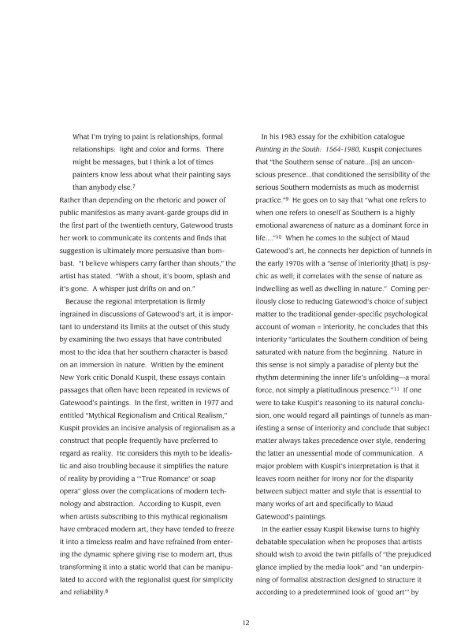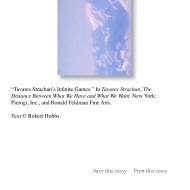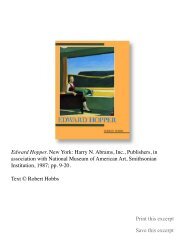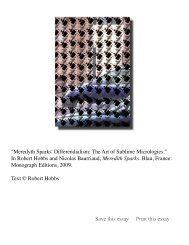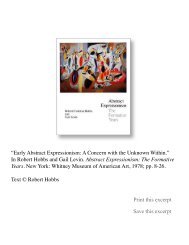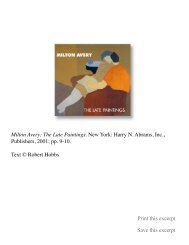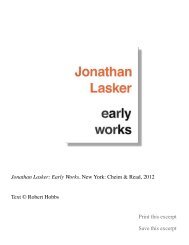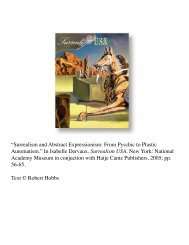Maud Gatewood: Re-Visions - Robert Hobbs
Maud Gatewood: Re-Visions - Robert Hobbs
Maud Gatewood: Re-Visions - Robert Hobbs
- No tags were found...
You also want an ePaper? Increase the reach of your titles
YUMPU automatically turns print PDFs into web optimized ePapers that Google loves.
What I'm trying to paint is relationships, formalrelationships: light and color and forms. Theremight be messages, but I think a Jot of timespainters know less about what their painting saysthan anybody else.?Rather than depending on the rhetoric and power ofpublic manifestos as many avant-garde groups did inthe first part of the twentieth century, <strong>Gatewood</strong> trustsher work to communicate its contents and finds thatsuggestion is ultimately more persuasive than bombast."I believe whispers carry farther than shouts," theartist has stated. "With a shout, it's boom, splash andit's gone. A whisper just drifts on and on."Because the regional interpretation is firmlyingrained in discussions of <strong>Gatewood</strong>'s art, it is importantto understand its limits at the outset of this studyby examining the two essays that have contributedmost to the idea that her southern character is basedon an immersion in nature. Written by the eminentNew York critic Donald Kuspit, these essays containpassages that often have been repeated in reviews of<strong>Gatewood</strong>'s paintings. In the first, written in 1977 andentitled "Mythical <strong>Re</strong>gionalism and Critical <strong>Re</strong>alism,"Kuspit provides an incisive analysis of regionalism as aconstruct that people frequently have preferred toregard as reality. He considers this myth to be idealisticand also troubling because it simplifies the natureof reality by providing a "'True Romance' or soapopera" gloss over the complications of modern technologyand abstraction. According to Kuspit, evenwhen artists subscribing to this mythical regionalismhave embraced modern art, they have tended to freezeit into a timeless realm and have refrained from enteringthe dynamic sphere giving rise to modem art, thustransforming it into a static w orld that can be manipulatedto accord with the regionalist quest for simplicityand reliability.SIn his 1983 essay for the exhibition cataloguePaintJng in the South: 1564- I 980, Kuspit conjecturesthat "the Southern sense of nature ... [is] an unconsciouspresence ... that conditioned the sensibility of theserious Southern modernists as much as modernistpractice."9 He goes on to say that "what one refers towhen one refers to oneself as Southern is a highlyemotional awareness of nature as a dominant force inlife ...."IO When he comes to the subject of <strong>Maud</strong><strong>Gatewood</strong>'s art, he connects her depiction of tunnels inthe early 1970s with a "sense of interiority [that] is psychicas well; it correlates with the sense of nature asindwelling as well as dwelling in nature." Coming perilouslyclose to reducing <strong>Gatewood</strong>'s choice of subjectmatter to the traditional gender-specific psychologicalaccount of woman = interiority, he concludes that thisinteriority "articulates the Southern condition of beingsaturated with nature from the beginning. Nature inthis sense is not simply a paradise of plenty but therhythm determining the inner life's unfolding-a moralforce, not simply a platitudinous presence." II If onewere to take Kuspit's reasoning to its natural conclusion,one would regard all paintings of tunnels as manifestinga sense of interiority and conclude that subjectmatter always takes precedence over style, renderingthe latter an unessential mode of communication. Amajor problem with Kuspit's interpretation is that itleaves room neither for irony nor for the disparitybetween subject matter and style that is essential tomany works of art and specifically to <strong>Maud</strong><strong>Gatewood</strong>'s paintings.In the earlier essay Kuspit likewise turns to highlydebatable speculation when he proposes that artistsshould wish to avoid the t~.Alin pitfalls of "the prejudicedglance implied by the media look" and "an underpinningof formalist abstraction designed to structure itaccording to a predetermined look of 'good art"' by12


